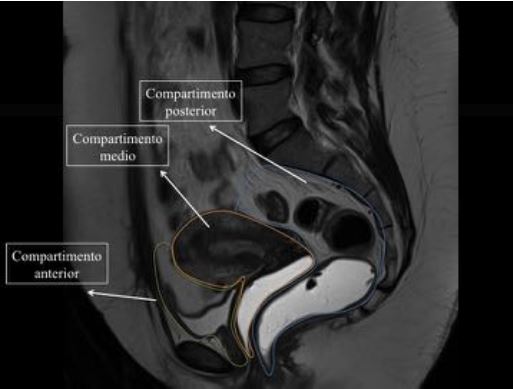ENDOMETRIOSIS:
EVALUACIÓN POR RESONANCIA MAGNÉTICA
Palabras clave:
ENDOMETRIOSIS, poster, seramResumen
Objetivos Docentes
El propósito de este poster es conseguir que todos lor radiólogos sean capaces de diagnosticar de una manera fácil y adecuada la endmetriosis mediante resonancia magnética. Conocer las secuencias básicas y protocolos de resonancia magnética utilizados para diagnóstico de esta patología, así como la anatomía de la pelvis femenina, y los hallazgos característicos de la endometriosis mediante resonancia magnética. Describiremos mediante ejemplos las localizaciones más frecuentes donde podemos encontrarnos esta entidad y su principal diagnóstico diferencial. Ilustraremos algunas de las complicaciones más frecuentes de la endometriosis mediante ejemplos. Con todo esto conseguiremos aportar claves para un diagnóstico rápido y eficaz de esta entidad.
Revisión del tema
INTRODUCCIÓN:
La endometriosis es una enfermedad ginecológica crónica y recurrente que afecta a mujeres en edad fértil, que puede manifestarse por infertilidad o dolor pélvico crónico. Está determinado por la presencia de tejido endometrial fuera de la cavidad uterina, en general en peritoneo pelviano, comprometiendo
órganos como ovarios, útero, trompas de Falopio, rectosigma y en menor grado intestino delgado, vejiga o pared abdominal.
Descargas
Citas
Chamié LP; Blasbalg R; Gonçalves MO et al. Accuracy of magnetic resonance imaging for diagnosis and preoperative assessment of deeply infiltrating endometriosis. Int J Gynaecol Obstet;106(3):198-201, 2009 Sep.
Itam SP; Ayensu-Coker L; Sanchez J et al. Adenomyosis in the adolescent population: a case report and review of the literature.J Pediatr Adolesc Gynecol;22(5):e146-7, 2009 Oct.
Jarrell JF; Vilos GA; Allaire C et al. Consensus Guidelines for the Management of Chronic Pelvic Pain. J Obstet Gynaecol Can; 27(9): 869-910, 2005 Sep.Loubeyre P; Petignat P; Jacob S et al. Anatomic distribution of posterior deeply infiltrating endometriosis on MRI after vaginal and rectal gel opacification. AJR Am J Roentgenol;192(6):1625-31, 2009 Jun.
Hensen JH; Puylaert JB. Endometriosis of the posterior cul-de-sac: clinical presentation and findings at transvaginal ultrasound. AJR Am J Roentgenol;192(6):1618-24, 2009 Jun.
Roy C; Balzan C; Thoma V et al. Efficiency of MR imaging to orientate surgical treatment of posterior deep pelvic endometriosis. Abdom Imaging;34(2):251-9, 2009 Mar-Apr.
Kikuchi I; Takeuchi H; Kuwatsuru R et al. Diagnosis of complete cul- de-sac obliteration (CCDSO) by the MRI jelly method. J Magn Reson Imaging;29(2):365-70, 2009 Feb.
Dessy LA; Buccheri EM; Chiummariello S et al. Umbilical endometriosis, our experience. In Vivo;22(6):811-5, 2008 Nov-Dec.
Biscaldi E; Ferrero S; Remorgida V et al. Rectosigmoid endometriosis with unusual presentation at magnetic resonance imaging. Fertil Steril;91(1):278-80, 2009 Jan.
Caramella T; Novellas S; Fournol M et al.[Deep pelvic endometriosis: MRI features].J Radiol;89(4):473-9, 2008 Apr.
Abrao MS; Gonçalves MO; Dias JA et al. Comparison between clinical examination, transvaginal sonography and magnetic resonance imaging for the diagnosis of deep endometriosis. Hum Reprod;22(12):3092-7, 2007 Dec.Kissler S; Zangos S; Kohl J et al. Duration of dysmenorrhoea and extent of adenomyosis visualised by magnetic resonance imaging.Eur J Obstet Gynecol Reprod Biol;137(2):204-9, 2008 Apr.
Kunz G; Herbertz M; Beil D et al. Adenomyosis as a disorder of the early and late human reproductive period. Reprod Biomed Online;15(6):681-5, 2007 Dec.
Low RS; Jones AO; Houang M et al. Endometriosis of the inguinal region: magnetic resonance imaging (MRI) findings. Australas Radiol;51 Suppl:B272-5, 2007 Dec.
Onbas O; Kantarci M; Alper F et al.Nodular endometriosis: dynamic MR imaging. Abdom Imaging;32(4):451-6, 2007 Jul-Aug.
Bazot M; Bornier C; Dubernard G et al.Accuracy of magnetic resonance imaging and rectal endoscopic sonography for the prediction of location of deep pelvic endometriosis. HumReprod;22(5):1457-63, 2007 May.
Marcelli F; Collinet P; Vinatier D et al. [Ureteric and bladder involvement of deep pelvic endometriosis. Value of multidisciplinary surgical management]. Prog Urol;16(5):588-93, 2006 Nov..
Carbognin G; Girardi V; Pinali L et al. Assessment of pelvic endometriosis: correlation of US and MRI with laparoscopic findings. Radiol Med;111(5):687-701, 2006 Aug.


